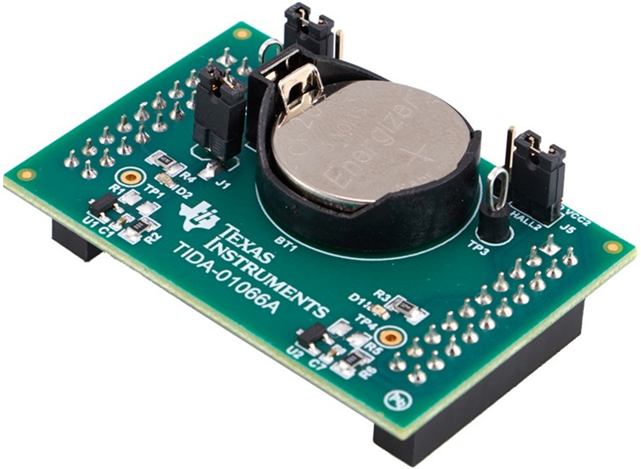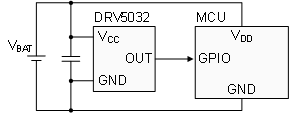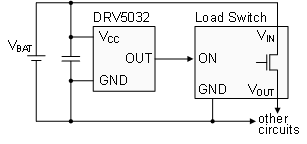-
Hall-Effect Sensors in Low-Power Applications SBOA196B September 2017 – November 2021 DRV5012 , DRV5013 , DRV5013-Q1 , DRV5023 , DRV5023-Q1 , DRV5032 , DRV5033 , DRV5033-Q1 , DRV5053 , DRV5053-Q1 , TMAG5231
-
Hall-Effect Sensors in Low-Power Applications
Hall-Effect Sensors in Low-Power Applications
Application Brief
Well-designed electronic systems only use as much power as they need to for each state of operation. While this is crucial for battery-powered systems, AC-powered systems also benefit from minimizing power, since that reduces heat dissipation, maximizes the product lifetime, and conserves electricity.
Low-power modes work best when they seamlessly transition to a higher power mode without the user taking separate action. This full automation will be paramount to smart systems of the future. When the power mode can change based on some mechanical movement occurring, Hall-effect sensors are often a suitable technology to be used.
Hall-effect Sensors
Semiconductor integrated circuits (ICs) with embedded Hall-effect sensing elements are used all over the world in everyday products for measuring position. These magnetic sensor devices are used in personal electronics, industrial systems, medical devices, automobiles, aircraft, and spacecraft. Although there are other magnetic sensing technologies, Hall-effect continues to be the most prevalent due to its unique set of advantages:
- Low Cost: ICs that incorporate Hall-effect elements are mass produced with standard CMOS processing flows.
- High reliability: being solid-state sensors that contactlessly measure magnetic fields, devices can operate for decades.
- Simplicity: while the inside of an IC incorporates thousands of complex circuits, the outside of most devices only has 3 pins. The output pin is a simple indicator of the proximity to a magnet, and standard microcontrollers can directly read it.
- Distance sensing: magnetic fields travel a distance and pass through most substances undisturbed. This allows sensors to be buried under enclosures where they are shielded from the environment and invisible to the user.
Applications
For years, laptop and tablet computers have used a transition detection implementation involving an embedded Hall-effect sensor and magnet to determine whether the lid is open or closed. This provides power efficiency with a fully automated wake-up scheme. When the lid is closed, all electronics can be powered off except for the sensor and a microcontroller monitoring its digital output. The DRV5032 and TMAG5231 ultra-low-power Hall-effect switches are designed for these applications.
Automotive systems are integrating more electronics than ever, and with that comes intelligent power management. To not drain a car battery when the engine is off, each electronic control unit (ECU) typically needs to use less than 100 µA. Power must be conserved and decisively used, and this can be accomplished by using sensors to gate power to primary circuits. Many systems are designed to temporarily increase power when an event happens, such as when a car door is opened, the steering wheel is moved, a pedal is pushed, a driver sits in the seat, or a console is opened. One method employed is to use low-power Hall sensors.
Medical pills that incorporate a video camera are an innovative, non-evasive solution for scoping the digestive tract of one’s body. The pill’s small size and outer smoothness are essential for the job. It would not be feasible to attach a power switch to the outside of the pill, yet the tiny battery inside must be conserved, so there is a need to wirelessly switch power on and off. Here, a low-power Hall-effect latch (such as the DRV5012) is a perfect solution for gating power. Prior to ingestion, the doctor activates the pill by bringing the north side of a magnet close, and power can be disabled using the south side. This is a far simpler, smaller, and more efficient implementation than using a wireless communication protocol.
Weight sensors can be created by placing a magnet and sensor closely apart, where weight will reduce the gap. These can be incorporated into chairs for detecting someone sitting down, which opens many possibilities of smart systems.
 Figure 1-1 Weight Sensor
Figure 1-1 Weight SensorNew security systems for door and window monitoring are going completely wireless. Using a local battery, wireless microcontroller, and Hall-effect sensor, these modular systems can operate for 10 years from one CR2032 coin cell. The TI reference design TIDA-01066 is an example of this. The premise of achieving such a long operating time from a small battery is to rely on the DRV5032 to detect a security breach, and only wake the CC1310 microcontroller if needed.
 Figure 1-2 Wireless Security
System
Figure 1-2 Wireless Security
SystemElectrical Considerations
The DRV5032 device comes in different versions of sampling rate and output driver: 5 Hz or 20 Hz, and push-pull or open-drain. The 5 Hz version uses less power, but it updates the output every 200 ms rather than 50 ms for the 20 Hz version. The push-pull output uses less power than the open-drain when a low-level is being driven, because the circuit for an open-drain has an external pullup resistor to VDD, and that causes a current leakage path into the open-drain equal to VDD / RPULLUP.
Since the DRV5032 device has an operating supply voltage of 1.65 to 5.5 V, it can be directly powered from various batteries, including a 3-V lithium-ion, two or three Alkaline or NiMH batteries in series, or a 4-V lithium-polymer. To estimate the battery life when powering the sensor, the mAh rating of the battery at its lowest specified current draw can be used, while also taking into account its self-discharge. For example, a typical CR2032 is rated at 210 mAh with 1% per year self-discharge. The DRV5032 5 Hz version typically uses 0.69 µA at 3 V. 210 mAh / 0.00069 mA = 300,000 hours, or about 26 years including self-discharge.
The digital output of a Hall sensor in a power gated system typically connects to a microcontroller GPIO or the control input of a load switch.
 Figure 1-3 Typical Microcontroller
Schematic
Figure 1-3 Typical Microcontroller
SchematicThe GPIO can be configured as an interrupt input to detect the change in sensor voltage, for deciding when to activate the rest of the system.
 Figure 1-4 Typical Load Switch
Schematic
Figure 1-4 Typical Load Switch
SchematicWhen a load switch is used, the designer should consider whether the magnet will be near or away from the sensor when system power is enabled. Most Hall-effect switches output a low voltage when the magnet is near, and high voltage when the magnet is away.
- If power should be enabled when the magnet is near the sensor, an active-low load switch should be used, such as the TPS22910A.
- If power should be enabled when the magnet is away from the sensor, an active-high load switch like the TPS22914 can be used.
Lastly, the magnetic sensor used does not necessarily need to have integrated low-power consumption. Low average power consumption can also be achieved by externally duty-cycling a sleep/enable pin (if the device has one), or by duty-cycling the VCC pin of the device, as described by the white paper SLYY058.
IMPORTANT NOTICE AND DISCLAIMER
| TI PROVIDES TECHNICAL AND RELIABILITY DATA (INCLUDING DATASHEETS), DESIGN RESOURCES (INCLUDING REFERENCE DESIGNS), APPLICATION OR OTHER DESIGN ADVICE, WEB TOOLS, SAFETY INFORMATION, AND OTHER RESOURCES “AS IS” AND WITH ALL FAULTS, AND DISCLAIMS ALL WARRANTIES, EXPRESS AND IMPLIED, INCLUDING WITHOUT LIMITATION ANY IMPLIED WARRANTIES OF MERCHANTABILITY, FITNESS FOR A PARTICULAR PURPOSE OR NON-INFRINGEMENT OF THIRD PARTY INTELLECTUAL PROPERTY RIGHTS. |
| These resources are intended for skilled developers designing with TI products. You are solely responsible for (1) selecting the appropriate TI products for your application, (2) designing, validating and testing your application, and (3) ensuring your application meets applicable standards, and any other safety, security, or other requirements. These resources are subject to change without notice. TI grants you permission to use these resources only for development of an application that uses the TI products described in the resource. Other reproduction and display of these resources is prohibited. No license is granted to any other TI intellectual property right or to any third party intellectual property right. TI disclaims responsibility for, and you will fully indemnify TI and its representatives against, any claims, damages, costs, losses, and liabilities arising out of your use of these resources. |
| TI’s products are provided subject to TI’s Terms of Sale (www.ti.com/legal/termsofsale.html) or other applicable terms available either on ti.com or provided in conjunction with such TI products. TI’s provision of these resources does not expand or otherwise alter TI’s applicable warranties or warranty disclaimers for TI products. |
| Mailing Address: Texas Instruments, Post Office Box 655303, Dallas, Texas 75265
Copyright © 2021, Texas Instruments Incorporated |